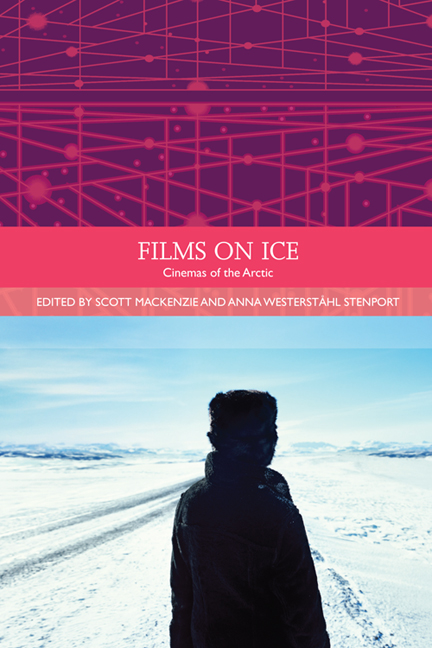Book contents
- Frontmatter
- Contents
- List of Illustrations
- Acknowledgements
- Traditions in World Cinema
- Introduction: What are Arctic Cinemas?
- PART I GLOBAL INDIGENEITY
- 1 ‘Who Were We? And What Happened to Us?’: Inuit Memory and Arctic Futures in Igloolik Isuma Film and Video
- 2 Northern Exposures and Marginal Critiques: The Politics of Sovereignty in Sámi Cinema
- 3 Frozen in Film: Alaska Eskimos in the Movies
- 4 Cultural Stereotypes and Negotiations in Sámi Cinema
- 5 Cinema of Emancipation and Zacharias Kunuk's Atanarjuat: The Fast Runner
- 6 Cosmopolitan Inuit: New Perspectives on Greenlandic Film
- 7 Arctic Carnivalesque: Ethnicity, Gender and Transnationality in the Films of Tommy Wirkola
- PART II HOLLYWOOD HEGEMONY
- PART III ETHNOGRAPHY AND THE DOCUMENTARY DILEMMA
- PART IV MYTHS AND MODES OF EXPLORATION
- Notes on the Contributors
- Index
4 - Cultural Stereotypes and Negotiations in Sámi Cinema
from PART I - GLOBAL INDIGENEITY
Published online by Cambridge University Press: 05 September 2016
- Frontmatter
- Contents
- List of Illustrations
- Acknowledgements
- Traditions in World Cinema
- Introduction: What are Arctic Cinemas?
- PART I GLOBAL INDIGENEITY
- 1 ‘Who Were We? And What Happened to Us?’: Inuit Memory and Arctic Futures in Igloolik Isuma Film and Video
- 2 Northern Exposures and Marginal Critiques: The Politics of Sovereignty in Sámi Cinema
- 3 Frozen in Film: Alaska Eskimos in the Movies
- 4 Cultural Stereotypes and Negotiations in Sámi Cinema
- 5 Cinema of Emancipation and Zacharias Kunuk's Atanarjuat: The Fast Runner
- 6 Cosmopolitan Inuit: New Perspectives on Greenlandic Film
- 7 Arctic Carnivalesque: Ethnicity, Gender and Transnationality in the Films of Tommy Wirkola
- PART II HOLLYWOOD HEGEMONY
- PART III ETHNOGRAPHY AND THE DOCUMENTARY DILEMMA
- PART IV MYTHS AND MODES OF EXPLORATION
- Notes on the Contributors
- Index
Summary
During the past decades, representations of Sámi culture in cinema in Norway have changed from emphasising the perspective of an outsider to emphasising that of an insider. This transition is related to a process of cultural revitalisation, which, as in a postcolonial framework, positions Sámi cinema practice, production and funding as a negotiating field for establishing a collective identity. This political, cultural and scholarly revitalisation has gained increasing prominence since the late 1950s, and has contributed to nuancing views on the Sámi as a diverse minority culture in the context of a long history of colonialism and assimilation policies. Portrayals exoticising and othering Sámis as savages or noble savages living in some distant, nature-bound past have historically homogenised the Sámi and disregarded them as active participants in larger national historic narratives or as part of a national majority population. Similar assumptions held sway in Sámi cultural studies until the 1960s (Hansen and Olsen 2004; Olsen 2010), as well as in most conventional studies of film representations (for example, Christophersen 1994; Wright 1998). This chapter addresses Sámi cinema history, a series of Sámi film case studies from 1987 to the present, and the role and function of the recently opened International Sámi Film Centre with the goal of foregrounding films that have a distinct connection with Sámi cultures in Sápmi and contribute to the (re) shaping of a collective understanding of cultural stereotypes in this context (for related chapters on Sámi cinema in this volume, see Kääpä on Finland, Chapter 2, and Dahlquist on Sweden, Chapter 21).
SÁMI FILM HISTORY
Visual representations of the Sámi can be traced back to the sixteenth century. The map Carta Marina (1539) and the explanatory and illustrated companion Historia de gentibus septentrionalibus (History of the Nordic People, 1555) by Swedish clergyman Olaus Magnus, and the illustrated book Lapponia (1673) by German Johannes Schefferus show a distinct Arctic landscape and people living in and by nature. These representations were widely disseminated, often as fanciful and false copies, to a European audience ignorant of Nordic cultures, and they have become stereotypes by repeatedly showing a traditional way of living associated with mountain highlands, hunting and gathering, reindeer herding and nomadism (Hoydalsnes 2003).
- Type
- Chapter
- Information
- Films on IceCinemas of the Arctic, pp. 72 - 83Publisher: Edinburgh University PressPrint publication year: 2014



